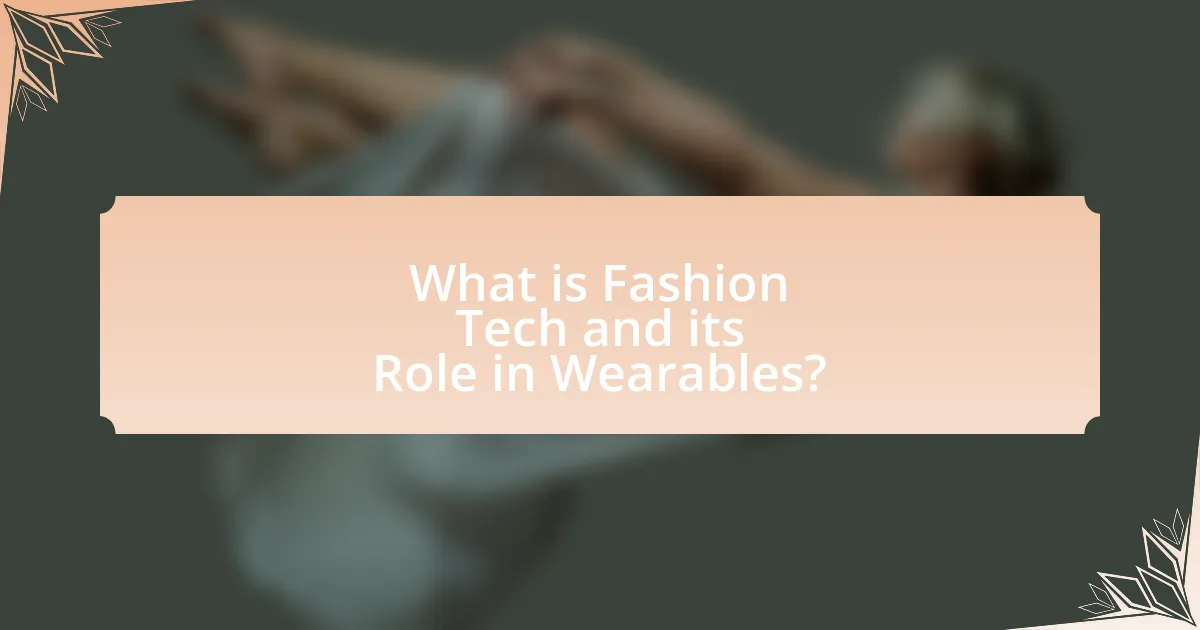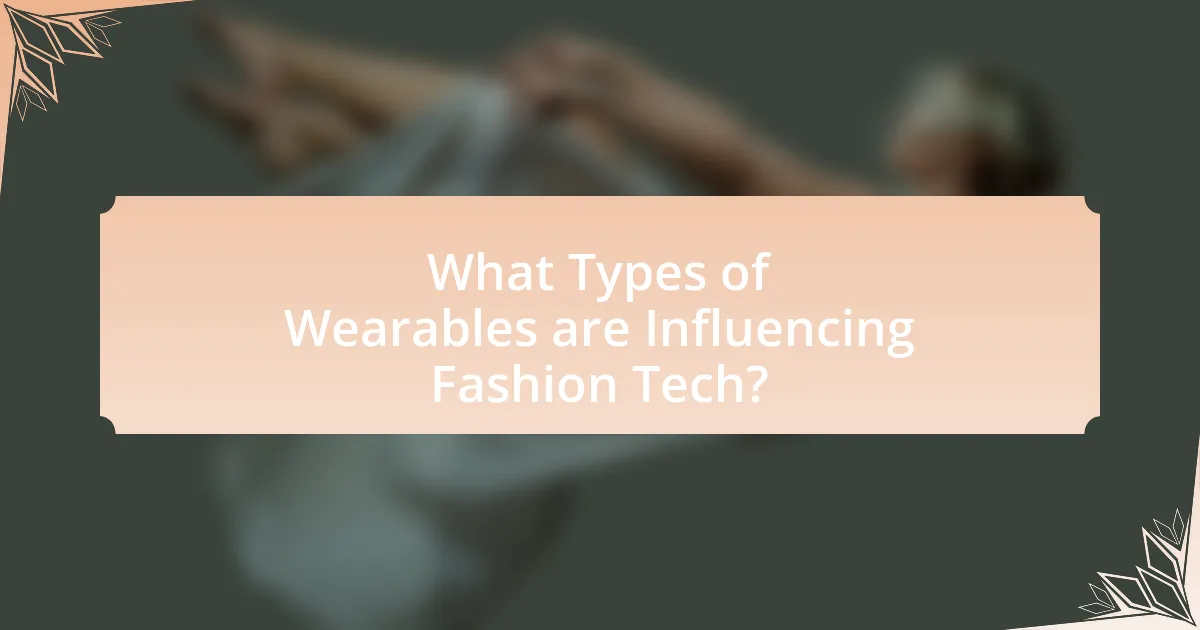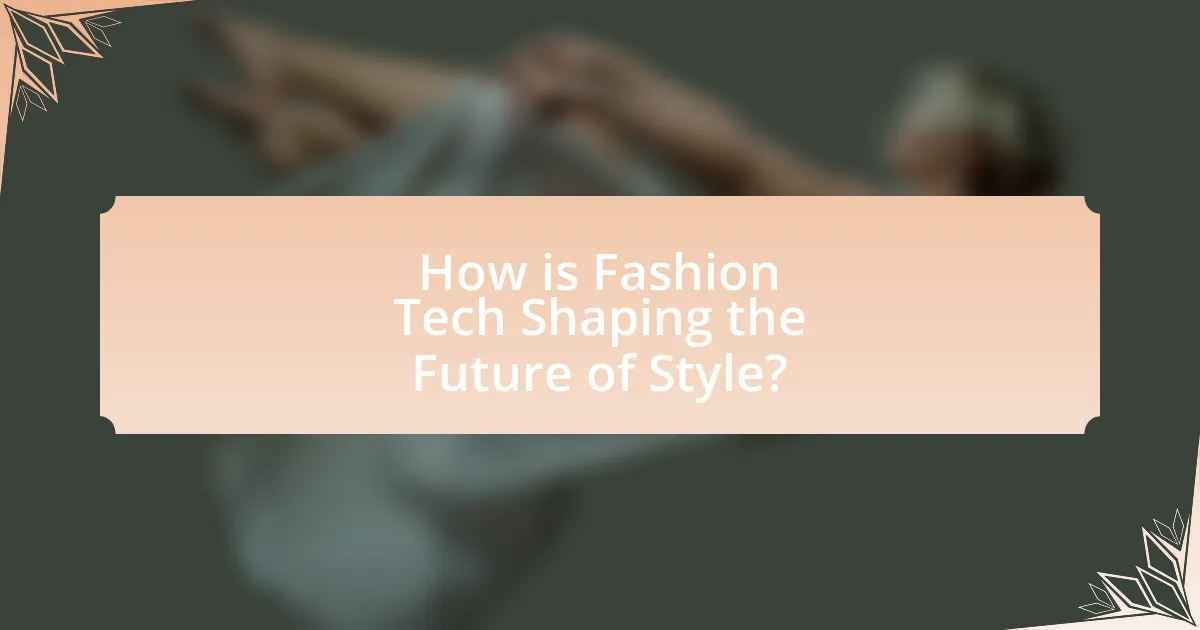Fashion Tech represents the convergence of technology and fashion design, particularly in the realm of wearable technology. This article explores how wearables, including smartwatches and fitness trackers, blend functionality with style, catering to consumer preferences for both aesthetics and practicality. Key technologies driving this sector include artificial intelligence, augmented reality, and smart textiles, which enhance user experience and personalization. The article also addresses the impact of Fashion Tech on consumer behavior, emerging trends, and the challenges faced by the industry, such as sustainability and privacy concerns. Additionally, it highlights popular categories of fashion wearables and offers practical tips for consumers when selecting these devices.

What is Fashion Tech and its Role in Wearables?
Fashion Tech refers to the integration of technology into fashion design and production, significantly impacting the development of wearable technology. Wearables, such as smartwatches and fitness trackers, exemplify this intersection by combining functionality with style, allowing users to monitor health metrics and receive notifications while maintaining aesthetic appeal. The global wearable technology market was valued at approximately $116 billion in 2021 and is projected to grow, indicating the increasing relevance of Fashion Tech in consumer preferences and lifestyle choices.
How does Fashion Tech integrate technology with fashion?
Fashion Tech integrates technology with fashion by incorporating smart textiles, wearable devices, and digital platforms into clothing and accessories. This integration allows for functionalities such as health monitoring, enhanced user interaction, and personalized fashion experiences. For instance, smart fabrics can change color or temperature based on environmental conditions, while wearable devices like smartwatches track fitness metrics and sync with mobile applications. The global market for wearable technology in fashion is projected to reach $60 billion by 2023, highlighting the significant impact and growth of this intersection.
What are the key technologies driving Fashion Tech?
Key technologies driving Fashion Tech include artificial intelligence, augmented reality, blockchain, and the Internet of Things (IoT). Artificial intelligence enhances personalization in fashion by analyzing consumer data to predict trends and preferences. Augmented reality allows customers to virtually try on clothing, improving the shopping experience and reducing return rates. Blockchain technology ensures transparency and traceability in supply chains, which is increasingly important for ethical fashion. The Internet of Things connects smart devices, enabling features like smart clothing that can monitor health metrics. These technologies collectively transform the fashion industry by improving efficiency, enhancing customer engagement, and promoting sustainability.
How do wearables fit into the Fashion Tech landscape?
Wearables are integral to the Fashion Tech landscape as they merge technology with personal style, enhancing functionality while maintaining aesthetic appeal. This integration is evident in products like smartwatches and fitness trackers, which not only serve practical purposes such as health monitoring but also feature customizable designs that align with fashion trends. According to a report by Statista, the global wearable technology market is projected to reach $62 billion by 2025, highlighting the growing consumer interest in stylish yet functional tech accessories. This trend illustrates how wearables are not just gadgets but essential fashion items that reflect individual identity and lifestyle choices.
Why is the intersection of wearables and style important?
The intersection of wearables and style is important because it enhances user experience by combining functionality with aesthetic appeal. Wearable technology, such as smartwatches and fitness trackers, must not only perform well but also align with personal fashion preferences to encourage adoption and daily use. Research indicates that 70% of consumers consider design as a key factor when purchasing wearable devices, highlighting the necessity for brands to integrate style into their products to meet market demands. This convergence fosters innovation in both technology and fashion, driving the development of products that are both practical and visually appealing.
What impact does Fashion Tech have on consumer behavior?
Fashion Tech significantly influences consumer behavior by enhancing personalization and convenience in shopping experiences. The integration of technology, such as augmented reality and AI-driven recommendations, allows consumers to visualize products better and receive tailored suggestions, leading to increased engagement and satisfaction. For instance, a study by McKinsey & Company found that 70% of consumers prefer personalized experiences, which Fashion Tech facilitates through data analytics and user interaction. This shift towards technology-driven shopping not only alters purchasing patterns but also fosters brand loyalty as consumers increasingly seek innovative and seamless interactions with fashion brands.
How does Fashion Tech influence fashion trends?
Fashion Tech significantly influences fashion trends by integrating technology into clothing and accessories, thereby enhancing functionality and aesthetics. Wearable technology, such as smartwatches and fitness trackers, has shifted consumer preferences towards garments that offer both style and utility, leading to a rise in athleisure and tech-infused fashion. For instance, the global smart clothing market is projected to reach $5.3 billion by 2025, indicating a growing consumer demand for innovative fashion solutions. This trend is further supported by collaborations between tech companies and fashion brands, exemplified by partnerships like Google and Levi’s, which create products that blend fashion with advanced technology.

What Types of Wearables are Influencing Fashion Tech?
Smartwatches, fitness trackers, smart clothing, and augmented reality glasses are the primary types of wearables influencing fashion tech. Smartwatches, such as the Apple Watch, integrate health monitoring and notifications, blending technology with personal style. Fitness trackers, like Fitbit, focus on health and activity data, promoting a lifestyle that merges fitness with fashion. Smart clothing, including garments with embedded sensors, enhances functionality while maintaining aesthetic appeal, as seen in brands like Athos. Augmented reality glasses, such as Google Glass, offer immersive experiences that combine digital information with the physical world, pushing the boundaries of traditional fashion. These wearables are reshaping consumer expectations and driving innovation in the fashion industry.
What are the most popular categories of fashion wearables?
The most popular categories of fashion wearables include smartwatches, fitness trackers, smart jewelry, and smart clothing. Smartwatches, such as the Apple Watch and Samsung Galaxy Watch, combine traditional watch features with smartphone notifications and health tracking capabilities. Fitness trackers, like Fitbit and Garmin devices, focus on monitoring physical activity and health metrics. Smart jewelry, including products from brands like Oura and Bellabeat, offers health tracking in a more discreet and stylish form. Smart clothing, exemplified by brands like Under Armour and Nike, integrates technology into fabrics for performance monitoring and enhanced user experience. These categories reflect the growing trend of merging technology with fashion, catering to consumers’ desire for both functionality and style.
How do smartwatches enhance personal style?
Smartwatches enhance personal style by offering customizable watch faces, interchangeable bands, and a variety of designs that cater to individual tastes. These features allow users to express their personality and match their smartwatch with different outfits or occasions. For instance, studies show that 70% of smartwatch users appreciate the ability to personalize their devices, indicating a strong correlation between smartwatch customization and personal expression. Additionally, brands like Apple and Samsung provide a range of styles from sporty to elegant, further enabling users to align their smartwatch with their fashion preferences.
What role do fitness trackers play in fashion?
Fitness trackers serve as both functional devices and fashion accessories, blending technology with personal style. They provide users with health and fitness data while also being designed to complement various outfits, thus influencing fashion trends. The integration of fitness trackers into everyday wear has led to collaborations between tech companies and fashion brands, resulting in stylish designs that appeal to consumers who prioritize aesthetics alongside functionality. For instance, brands like Fitbit and Garmin have released models that resemble traditional jewelry, demonstrating how fitness trackers can enhance personal style while promoting an active lifestyle.
What innovations are emerging in wearable technology?
Innovations in wearable technology include advanced health monitoring features, smart textiles, and augmented reality integration. Health monitoring devices now offer continuous tracking of vital signs, such as heart rate and blood oxygen levels, with some wearables capable of detecting irregularities that may indicate health issues. Smart textiles are being developed to incorporate sensors directly into fabrics, enabling functionalities like temperature regulation and biometric data collection. Additionally, augmented reality is being integrated into wearables, allowing users to interact with digital content in real-world environments, enhancing both functionality and user experience. These advancements reflect a growing trend towards more personalized and interactive wearable devices in the fashion tech sector.
How are smart fabrics changing the fashion industry?
Smart fabrics are revolutionizing the fashion industry by integrating technology into textiles, enabling garments to respond to environmental stimuli and user interactions. These fabrics can monitor health metrics, adjust temperature, and even change color or pattern based on the wearer’s preferences or surroundings. For instance, companies like Wearable X have developed smart yoga pants that provide haptic feedback to guide users through poses, demonstrating the practical application of this technology in activewear. Additionally, the global smart textiles market is projected to reach $5.5 billion by 2024, highlighting the growing demand and investment in this sector.
What advancements are being made in augmented reality for fashion?
Advancements in augmented reality (AR) for fashion include the development of virtual fitting rooms, which allow customers to try on clothing and accessories digitally before making a purchase. Companies like Zara and ASOS have implemented AR technology to enhance the shopping experience, enabling users to visualize how garments will look on them through smartphone apps. Additionally, AR is being used for interactive marketing campaigns, such as Gucci’s use of AR filters on social media platforms, allowing users to see products in a virtual environment. These advancements are supported by the increasing integration of AR with artificial intelligence, improving personalization and user engagement in the fashion retail sector.

How is Fashion Tech Shaping the Future of Style?
Fashion tech is shaping the future of style by integrating advanced technologies such as artificial intelligence, augmented reality, and wearable devices into the fashion industry. These innovations enhance personalization, allowing consumers to experience customized shopping through virtual fitting rooms and AI-driven recommendations. For instance, companies like Stitch Fix utilize algorithms to curate personalized clothing selections based on individual preferences, resulting in a more tailored shopping experience. Additionally, wearable technology, such as smart fabrics and fitness trackers, merges functionality with fashion, enabling consumers to monitor health metrics while maintaining style. This convergence of technology and fashion not only transforms consumer engagement but also drives sustainability through data-driven insights that optimize production processes and reduce waste.
What challenges does the Fashion Tech industry face?
The Fashion Tech industry faces significant challenges, including rapid technological advancements, sustainability concerns, and consumer adoption barriers. Rapid technological advancements create pressure for companies to innovate continuously, often leading to high research and development costs. Sustainability concerns arise from the environmental impact of production processes and materials used in fashion tech, with consumers increasingly demanding eco-friendly solutions. Additionally, consumer adoption barriers exist due to a lack of awareness and understanding of wearable technology, which can hinder market growth. These challenges are compounded by the need for collaboration between fashion designers and tech developers to create products that are both stylish and functional.
How do privacy concerns affect wearable technology adoption?
Privacy concerns significantly hinder the adoption of wearable technology. Consumers often fear that their personal data, such as health metrics and location information, may be misused or inadequately protected by manufacturers. A survey conducted by the Pew Research Center found that 60% of Americans are concerned about how their data is collected and used by technology companies, which directly impacts their willingness to embrace wearables. This apprehension leads to a reluctance to invest in devices perceived as invasive or insecure, ultimately stalling market growth and innovation in the wearable technology sector.
What are the sustainability issues related to Fashion Tech?
Sustainability issues related to Fashion Tech include excessive resource consumption, electronic waste, and ethical labor practices. The fashion tech industry often relies on materials and processes that are not environmentally friendly, leading to significant water usage and pollution. For instance, the production of synthetic fabrics, commonly used in wearables, contributes to microplastic pollution in oceans. Additionally, the rapid pace of technological advancement results in a high turnover of devices, creating electronic waste that is difficult to recycle. According to a report by the Global Fashion Agenda, the fashion industry is responsible for 92 million tons of waste annually, highlighting the urgent need for sustainable practices. Furthermore, labor conditions in tech manufacturing often fail to meet ethical standards, raising concerns about worker exploitation.
What are the future trends in Fashion Tech and wearables?
Future trends in Fashion Tech and wearables include the integration of advanced materials, such as smart textiles that can monitor health metrics, and the rise of augmented reality (AR) in shopping experiences. Smart textiles, which can change color or texture based on user preferences or environmental conditions, are being developed by companies like Wearable X and Google. Additionally, AR technology is enhancing online shopping by allowing consumers to virtually try on clothing, as seen in apps like Snapchat and IKEA Place. The market for wearables is projected to grow significantly, with Statista estimating that the global wearables market will reach $60 billion by 2023, driven by consumer demand for multifunctional devices that blend fashion with technology.
How will AI influence the design of wearables?
AI will significantly influence the design of wearables by enabling personalized user experiences and enhancing functionality. Through machine learning algorithms, AI can analyze user data to tailor wearable devices to individual preferences, such as adjusting fitness tracking metrics based on activity levels or customizing notifications based on user behavior. For instance, a study by McKinsey & Company highlights that AI-driven personalization can increase user engagement by up to 30%. Additionally, AI can optimize the design process itself, using generative design techniques to create more efficient and aesthetically pleasing wearable forms, as demonstrated by companies like Adidas, which employs AI to innovate in product design.
What role will personalization play in future fashion tech products?
Personalization will play a crucial role in future fashion tech products by enhancing user experience and driving consumer engagement. As technology advances, brands will leverage data analytics and artificial intelligence to create tailored recommendations, ensuring that products align with individual preferences and styles. For instance, a study by McKinsey & Company found that personalized experiences can lead to a 10-30% increase in sales, demonstrating the financial impact of customization in fashion tech. This shift towards personalization not only fosters brand loyalty but also allows consumers to express their unique identities through fashion, making it a key component in the evolution of the industry.
What practical tips can consumers follow when choosing fashion wearables?
Consumers should prioritize functionality, style, and compatibility when choosing fashion wearables. Functionality ensures that the wearable meets specific needs, such as fitness tracking or notifications, while style guarantees that it aligns with personal aesthetics. Compatibility with smartphones and other devices is crucial for seamless integration and usability. Research indicates that 70% of consumers consider design as important as functionality in wearables, highlighting the need for a balance between these factors. Additionally, checking user reviews and ratings can provide insights into the performance and durability of the wearable, further aiding in informed decision-making.
How can consumers ensure compatibility with their devices?
Consumers can ensure compatibility with their devices by checking the specifications and requirements of both the wearable technology and their existing devices. This involves reviewing the operating system compatibility, connectivity options such as Bluetooth or Wi-Fi, and any necessary app requirements. For example, many wearables require specific versions of operating systems like iOS or Android to function properly, which can be verified on the manufacturer’s website. Additionally, consumers should consult user reviews and product documentation to confirm that the wearable integrates seamlessly with their devices, as compatibility issues can often be highlighted by other users.
What should consumers consider regarding style and functionality?
Consumers should consider the balance between aesthetic appeal and practical usability when evaluating style and functionality in fashion tech. A wearable device should not only complement personal style but also enhance user experience through features like comfort, durability, and ease of use. For instance, a smartwatch that integrates seamlessly with daily activities while offering a stylish design can significantly improve user satisfaction. Research indicates that 70% of consumers prioritize design alongside functionality when purchasing wearable technology, highlighting the importance of this balance in consumer decision-making.